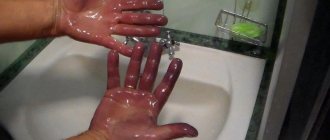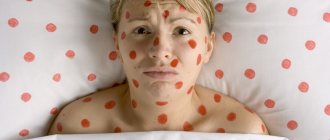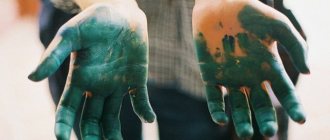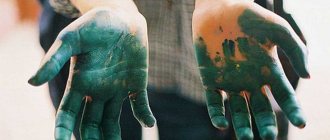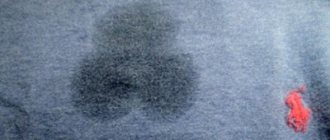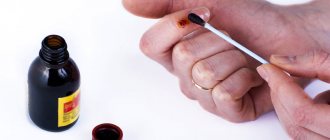Fukortsin is an effective drug for disinfecting wounds, ulcers of various origins and abrasions. Its characteristic crimson color is given by an antimicrobial dye – fuchsin. The period of its disappearance from the skin depends on the number of layers applied. On average it takes 5-6 days. But if necessary, you can try to wash Fukortsin stains from skin, furniture and other surfaces using folk methods.
Household chemicals for removing fucorcin stains
White.
This chemical bleach removes any dye. But it is very strong and toxic, so it is not suitable for painted surfaces. Can be used for white things and objects - window sill, window frame, table top. Do not use on skin to avoid burns. To remove stains, apply a few drops of bleach to a cotton pad and wipe away the stain.
Dishwashing liquid.
This is a safe method that will help remove fresh stains. Can be used on leather, furniture and fabrics. Apply a little gel to the sponge and rub it over the painted area. Then wipe the surface with a damp cloth.
Dentifrice.
Soft abrasives do an excellent job of removing dirt. Sprinkle some powder onto the surface, dampen a brush or sponge in clean water and scrub. Periodically add a new portion of powder. Finally, rinse the surface with clean water.
Antistatic.
Suitable for removing old traces of fucorcin that have already begun to fade. Spray an antistatic agent onto the stain and wipe it with a cotton pad, bandage or rag. Repeat the procedure until the contamination is completely removed.
Recommendations for proper cleaning
When using Fukortsin, it is better to take precautions, since stains on some surfaces are very difficult to remove.
Fukortsin stains are difficult to remove, and this is due to its composition. It contains a special substance called fuchsin. It is this that gives the medicinal composition such a bright color.
Minor stains on the skin, teeth and hair gradually disappear on their own, but on interior items, furniture and floor coverings they will have to be removed forcibly. Fresh stains are easier to remove, so don’t waste your time. Old stains have to be removed using aggressive household products that can damage the stained surface.
You need to understand that it is unlikely that you will be able to get rid of pollution in one approach. As a rule, there is a need to repeat the procedure after a few hours and this also does not provide a 100% guarantee that the stain will disappear.
To remove stains from the skin of the face and body, it is strictly forbidden to use stain removers, solvents and other aggressive compounds. As for clothes, bedding and carpets, if you cannot get rid of the dirt, you need to seek help from a dry cleaner. For their work, they use expensive professional cleaning compounds that can remove stubborn stains.
Cosmetical tools
Hand cream.
Penetrating into the skin, it dilutes the coloring pigment fucorcin and accelerates its removal. Apply a little cream to the skin and wait until it is absorbed. Repeat the procedure 2-3 times a day.
Baby milk.
Apply the product to the scarlet stain and wait 10–15 minutes. Wash off the composition with warm running water and soap. If it is not possible to wash your hands, wipe your skin with a damp cloth.
Eau de Toilette.
Eau de toilette contains alcohol, which will dissolve the coloring pigment. To remove a stain, soak a cotton swab or pad in eau de toilette and dab onto the stain.
Micellar water.
To deal with stains, apply micellar water to a cotton pad and rub the stained area. Repeat the action several times until the stain disappears.
Why is Fukortsin so difficult to wipe off?
This medicine does an excellent job of disinfecting abrasions, wounds and painful pustules, for example, with chickenpox. contains fuchsin, an aniline dye with antifungal properties, which gives Fukortsin a purple-crimson hue. Because of its bright color, the drug is also called Castellani paint.
Before removing stains from the leather, check its condition carefully. If the damage has not healed, Fukortsin cannot be removed.
Pharmacy drugs
Medical alcohol.
Pure alcohol (76% or 96%) is suitable for treating furniture, clothing and floors. For skin, use an alcohol solution - 40–50%. Soak a cotton pad in alcohol or alcohol solution and rub the stain. Treat your skin with baby cream to protect it from drying out.
Chlorhexidine.
Has a slight whitening effect, so use with caution on colored materials. To get rid of traces of fucorcin, soak a cotton pad in chlorhexidine and rub the contaminated area.
Hydrogen peroxide.
Apply a little peroxide to the stain and wipe it with a cotton pad. Repeat the procedure if necessary. Before you start processing fabric, test the product on an inconspicuous area - peroxide can ruin the unstable dye.
Acetylsalicylic acid.
To remove the pigment, prepare a solution. To do this, crush an Aspirin tablet and add it to 50 ml of water. Apply the composition to the painted area of skin, furniture or clothing and wait until the trace of fucorcin fades. If traces remain, repeat the procedure 2-3 times.
Basic properties and composition
Fukortsin is a disinfectant used for minor skin lesions, chickenpox, and seborrhea. Thanks to its complex composition, it has an antiseptic, antifungal, and wound-healing effect. The purpose of the medication is to counteract infection.
The main components of the external medicine:
- Carbolic acid (5% solution). Phenol derivative. It is used in medicine and pharmacology for staphylococcal, streptococcal, and parasitic infections. The therapeutic effect is achieved by destroying cellular synthesis. It has antiseptic properties, mobilizing the dehydration mechanism. Toxic to the central nervous system. Gives Fukortsin a recognizable smell. Dissolves in water at elevated temperatures, oil and alcohol.
- Boric acid. It dissolves well in alcohol and hot water. Suppresses fungal and bacterial infections. Absorbs into the skin and dries the wound. Poisonous.
- Resorcinol (2% solution). Diatomic phenol. At this concentration it has wound-healing and anti-inflammatory properties.
- Fuchsin (rosaniline). A type of synthetic aniline dye. An aqueous solution of hydrochloride/acetic acid salt of rosaniline. Poisonous. Used to suppress fungal infections. Gives the medicine a red color that is not immediately washed off from the skin.
Auxiliary solvent ingredients:
- acetone;
- ethanol;
- distilled water.
The drug is applied pointwise to the affected areas, without touching healthy skin, in order to reduce the toxic effect of the drug.
Traditional methods
Starch and soda.
Mix starch and soda in a 1:2 ratio. Moisten the stain with water and treat with the prepared mixture. Rub the product into the skin in a circular motion. Wait 10 minutes and rinse off any remaining powder with water.
Alcohol, oil, aspirin.
When deciding how to remove fucorcin from the skin, pay attention to this method: it is effective and gentle, so it is suitable for treating skin. Aspirin and alcohol dissolve the dye, and the oil prevents dryness.
Follow the recipe:
- Crush one aspirin tablet.
- Add 1 tsp. olive oil and 0.5 tsp. alcohol
- Treat the painted area with a cotton swab.
Finally, rinse off with warm water.
Soda and lemon.
Mix 2 tsp. baking soda with the juice of half a lemon. Soak a cotton pad in the solution and treat the fucorcin mark with it. Wash your skin under running water or wash your clothes as usual.
Oil and baby cream.
Mix the oil and baby cream in a 1:1 ratio and rub the mixture in a circular motion into the skin. Remove the greasy product by rinsing with warm water and soap.
Glycerin and milk.
Prepare a cleaning solution by mixing glycerin and milk in a 1:1 ratio. Heat the solution slightly in a water bath - it should be slightly warm to the touch. Massage the product into the skin using a cotton swab or disk. After 10 minutes, rinse the mixture with warm water.
How to Remove Pink Stains from Teeth
Do not open medication bottles with your teeth as they may become stained. We clean tooth enamel in the following ways:
- Mix baking soda (1 tbsp) with freshly squeezed lemon juice (1/2 citrus). Apply the resulting mass to a toothbrush and carefully remove traces of the drug.
- Instead of lemon juice, use a small amount of hydrogen peroxide. After cleaning your teeth, rinse the solution thoroughly.
Rules for cleaning different surfaces
How to wash fucorcin from skin.
Traces of the drug will disappear when the wound heals and the crusts peel off. You should not treat damaged areas of the skin - you can cause an infection or slow down healing.
To remove traces of dye, use lemon juice, alcohol, salicylic acid, or tooth powder. Rough skin (for example, on your hands) can be rubbed harder - this way you will get results faster. After treatment, do not forget to lubricate your skin with moisturizer.
Facial skin is more sensitive, so do not use alcohol-containing or abrasive substances for cleansing. For oily skin types, lemon juice is suitable; for dry and normal skin types, micellar water, baby milk, and hydrogen peroxide are suitable.
Children's skin is very delicate, so you will need a gentle product that will not cause irritation or allergies. The best solution is to wait until the pink marks go away on their own. If you need a quick effect, then treat the skin with vegetable oil, baby soap or cream.
From hair.
Mix ammonia and olive oil (1:1) and apply the solution to the strands. Wait 10 minutes, then wash your hair with shampoo. On light hair, the marks will be especially noticeable, so the procedure will have to be repeated 2-3 times.
Zubov.
If you have stained your tooth enamel, a regular whitening paste will help. If the remedy does not help, brush your teeth with a mixture of baking soda and lemon juice.
Clothes.
It's easier to remove fresh stains, so don't put off washing. Immediately remove the soiled item and soak in a soapy solution with warm water. Finally, wash and dry. Clean white clothes with bleach, bleach or a strong stain remover. Rub the product in with a clothes brush and then rinse the item. If you can’t remove stains yourself or are afraid of ruining delicate fabric, it’s better to contact a dry cleaner.
Plumbers.
To clean fucorcin stains from a sink, bathtub, or toilet, use acetone. Wet the sponge and wipe away the dirt. An alternative method is bleach or a special cleaning product for plumbing fixtures.
Paula.
You can remove pink stains from linoleum using alcohol. For carpets, use a store-bought stain remover. A solution of ammonia and laundry soap is suitable for carpet.
Furniture.
To remove stains from varnished furniture, dilute baking soda with water and apply the mixture to the stain. Then polish the surface.
Fucorcin can be removed from a sofa or chair using chlorine-containing bleaches. Dilute the bleach with a small amount of water and test the solution on an inconspicuous area of the material. Strong bleach can ruin the dye, so it's best to use it to remove stains from white upholstery.
Another option is a mixture of laundry soap and ammonia. Rub the block on a grater and dissolve the shavings in alcohol in a 1:1 ratio. Soak a sponge in the solution and treat traces of fucorcin.
Floors, furniture, clothes
To clean the surfaces of furniture or fabric, you need to make a little effort.
Often not only the skin, but also the surfaces of furniture and floors are contaminated with fucorcin. Here it is important to act quickly and effectively; if the stain has dried, it will be more difficult or even impossible to wash it off.
We clean the floors.
Bleach, with or without chlorine, will be effective in use. If you use bleach, you need to act carefully and quickly so as not to spoil the floor. If you use products without chlorine, it will take longer, but you will definitely get results.
A pharmaceutical product, sodium sulfate, will also help. The substance is quite aggressive, so you need to quickly and intensively wipe the surface, then rinse with water.
The result depends on the age and size of the stain, but it is important not to give up, it is washable.
Did Fukortsin get on the furniture?
Don’t despair, all you have to do is take a cloth, sprinkle it with baking soda and vigorously rub it into the surface. It will take quite a long time, but there will be results. If you add acetone or vodka, the process will speed up significantly. This product is quite effective even with significant contamination.
Children painted the walls with wax crayons: a life hack on how to clean wallpaper with a hairdryer
Salicylic acid is an effective remedy not only for cleansing the skin, it will clean the surface in a minute. Apply and wash off!
We save clothes.
If there are a lot of stains and they are small, they can be easily removed with bleach. Any products containing chlorine will be effective. But chlorine is also harmful and should not be used on all types of fabrics. Sodium sulfate is also used, which is no less effective, but dangerous for tissues.
They must be used very carefully and quickly.
It is unacceptable to use bleach for colored items; in this case, it is better to throw it away immediately. But there are products that will help, for example, chlorine-free bleaches for colored clothes. But you will have to soak it for a long time and more than once.
You can wash the product from tissues with more aggressive agents, which are strictly prohibited for use on the skin. Yes, the products will be effective, but the skin is more expensive!
But red stains are easier to wash off from leather than from fabric or furniture. Therefore, you need to be patient. The stains will become lighter in color over time and will disappear only after a few cleanings.
Things to remember
- Try to immediately soak the soiled item in a soap solution so that the fucorcin pigment does not have time to penetrate deeply into the material.
- Choose gentle ingredients for your skin, and apply a moisturizer after the procedure.
- Test cleaning products on inconspicuous areas of clothing and furniture to avoid damaging the material or color.
- Cosmetics act gently and do not cause harm to the skin and other surfaces. But the effect of use is not too strong, so the procedure will have to be repeated many times.
- In the fight against fucorcin, all alcohol-based pharmaceutical products (disinfectants) are suitable.
Cleaning linoleum
Using this drug, you can accidentally spill it on the floor, for example, on linoleum. Floor coverings are cleaned of fucorcin using chlorine-containing products.
Chlorine bleach or even a toilet sink, such as Domestos, will work as a cleaning agent. With such products, fucorcin is washed off instantly, but you should work with them very quickly so as not to spoil the color of the linoleum.
Less effective, but safer for linoleum stain remover "Vanish". They can also wash off the medicine, but it is unlikely to be done the first time.
Linoleum and laminate flooring can also be easily cleaned with baking soda. You just need to sprinkle a little baking soda on the moistened stain and wipe the stained area with a sponge. Use this method carefully so as not to damage the coating with scratches.
Reviews: “My chemist grandfather suggested diluting tooth powder with alcohol”
Strong tea leaves to the rescue!!! the child stained his nose with a solution of fucorcin. after the first treatment of the nose with tea leaves it became much lighter, now I’ll sleep and treat it again, I think 2 more times and tomorrow we’ll go to kindergarten with a clean nose.
olya goloshchapova, https://www.baby.ru/blogs/post/19210968-5133211/
I wiped off fucorcin stains from the furniture and from the microwave and the floor (linoleum) with one cool product called Milam (a product for removing scale and soot), then applied it with a sponge and rubbed it all off, and where it didn’t come off, I rubbed it with a metal utensil hedgehog very carefully so as not to scratch, but voila!! there was no fucorcin! But it got on my jeans and I don’t know how to wipe it off yet)))
Katya, https://www.woman.ru/home/medley9/thread/4402156/
This is a poisonous crimson liquid that eats into any surface to death. I only have experience in removing it from the carpet. Linoleum, the table - they cannot be washed with anything. But the carpet was washed with a carpet cleaner from some of our companies, no Vanisha!!! The third time, the stains turned pale pink, and my carpet was beige. I don’t remember the name of the product - unsightly brown plastic packaging...
new-fikus, https://2009-2012.littleone.ru/archive/index.php/t-4592032.html
We spilled fukortsin on white apartek (this is artificial leather). I tried to scrub it off with fairies, white wine and alcohol. the effect was but small. then the chemist grandfather arrived and made a mixture - ordinary tooth powder diluted with alcohol to a paste. Apply to the stain and wait. When it hardens, remove it several times. when he left, a halo from the stain remained. Then I repeated the operation 1-2 times a day for several days. The result is that we now have no trace of the former catastrophe.
lples ***, https://eva.ru/house-and-hobby/messages-2363985.htm
domznatok.ru
Why is fucorcin needed and is it possible not to leave traces of it?
Most housewives use fucorcin in everyday life, because, in addition to infections, it also kills fungi. But first of all, this is a liquid substance that can be spilled (which most often happens thanks to the “wonderful” Sovdepov packaging method, when, in addition to the lid, you also need to remove the cap. Often, it is when this cap is uncorked that spillage occurs. Why- then the manufacturers don’t want to replace it with something else.
In addition to leather, after application, the dye often remains on furniture, carpets, linoleum and other surfaces in the home. How to wash off fucorcin when it has already left its marks? We have several effective methods in our arsenal, so get rid of despair and let's act.
Delicate fabrics
It is more difficult to remove fucorcin from thin and delicate tissues. If the item has been lying around for a long time, the print will not be removed even by dry cleaning. Then how can you try to eliminate the pink mark? It is better to wash a wool product with horse shampoo.
A thin, delicate cloth can be soaked in hydrogen peroxide mixed with shaving foam. After treating the stain, wash the entire item with laundry soap. If immediately after the antiseptic gets on the fabric, you spill the print with mineral water with a high content of bicarbonates, for example, Essentuki 17, then subsequent washing with powder for delicate fabrics is more likely to remove the stain.
